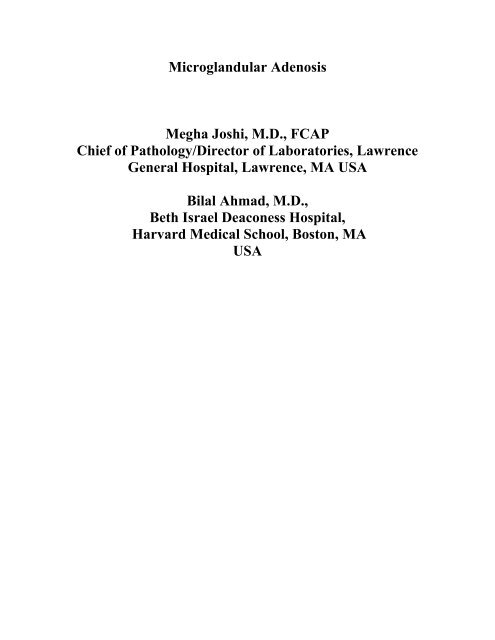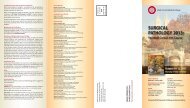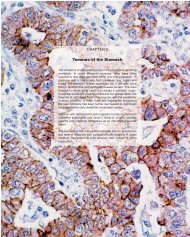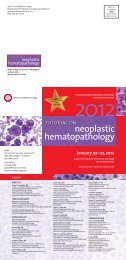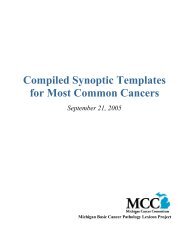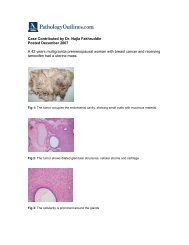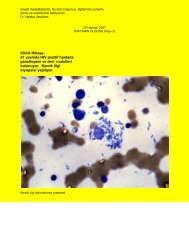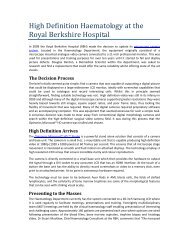article by Drs. Joshi and Ahmad (May 2011) - Pathology Outlines
article by Drs. Joshi and Ahmad (May 2011) - Pathology Outlines
article by Drs. Joshi and Ahmad (May 2011) - Pathology Outlines
You also want an ePaper? Increase the reach of your titles
YUMPU automatically turns print PDFs into web optimized ePapers that Google loves.
Microgl<strong>and</strong>ular Adenosis<br />
Megha <strong>Joshi</strong>, M.D., FCAP<br />
Chief of <strong>Pathology</strong>/Director of Laboratories, Lawrence<br />
General Hospital, Lawrence, MA USA<br />
Bilal <strong>Ahmad</strong>, M.D.,<br />
Beth Israel Deaconess Hospital,<br />
Harvard Medical School, Boston, MA<br />
USA
Microgl<strong>and</strong>ular Adenosis<br />
Microgl<strong>and</strong>ular adenosis (MGA) is a rare breast lesion that is often detected incidentally<br />
<strong>and</strong> occasionally presents as a mass 1 . It has an infiltrative pattern <strong>and</strong> the gl<strong>and</strong>s are<br />
haphazardly distributed in a hypocellular or fibrous matrix with extension into fatty<br />
stroma (Fig. 1). The gl<strong>and</strong>s are small, round, uniform <strong>and</strong> lined <strong>by</strong> a single layer of flat<br />
to cuboidal epithelial cells. The cytoplasm may be vacuolated or granular. Absence of a<br />
myoepithelial layer is the sine qui non of this lesion (Fig. 2,3). In a retrospective review<br />
of 65 cases 2 containing a diagnosis of MGA at MD Anderson, up to 85% were instead<br />
found to represent other forms of adenosis <strong>by</strong> virtue of an intact, SMA-positive<br />
myoepithelial layer. Nonetheless, its benign nature is affirmed <strong>by</strong> the presence of a<br />
surrounding multilayered basement membrane highlighted <strong>by</strong> stains for reticulin, type IV<br />
collagen (Fig. 4) <strong>and</strong> laminin 3 .<br />
Fig. 1.MGA: Gl<strong>and</strong>s infiltrating fat. H&E 20X<br />
Fig.2 MGA: No staining for p63<br />
Absent myoepithelial cells (20X)<br />
Fig.3 MGA: No myoepithelial cells<br />
Colponin negative (20X)<br />
Fig.4 MGA: Type IV collagen shows<br />
presence of basement membrane (20X)
The infiltrative pattern of growth may cause confusion with low-grade invasive ductal<br />
(tubular) carcinomas. The latter is distinguished <strong>by</strong> a stellate “tear-drop” growth pattern<br />
<strong>and</strong> a desmoplastic stromal response 4 . In addition, the gl<strong>and</strong>s of MGA contain a<br />
characteristic PAS-positive, diastase-resistant, eosinophilic material not present in tubular<br />
carcinoma. The immunophenotypic profile is peculiar <strong>and</strong> further helps distinguish<br />
MGA from invasive carcinoma. The gl<strong>and</strong>s are S100 positive (Fig. 5, 10) <strong>and</strong> negative<br />
for estrogen/progesterone receptors (ER/PR) <strong>and</strong> HER-2 (Fig. 6) (triple-negative<br />
phenotype), but EGFR positive (Fig. 7, 8) (Table 1). In contrast to the strong EMApositivity<br />
that is observed in benign <strong>and</strong> malignant gl<strong>and</strong>ular breast lesions, the<br />
epithelium in MGA is typically negative or only focally positive.<br />
Several studies suggest that MGA may represent a non-obligate precursor to invasive<br />
breast carcinoma based upon the presence of an invasive component in up to 27% of<br />
patients 2 . A spectrum of microgl<strong>and</strong>ular proliferations from benign adenosis(Fig 1) to<br />
atypical MGA (Fig. 16)(AMGA) <strong>and</strong> breast carcinoma arising in MGA (MGACA)(Fig.<br />
9) has been described 5 . All three lesions may be present in a single case, (Figs.1-22) <strong>and</strong><br />
are thought to represent true progression <strong>by</strong> virtue of a similar immunophenotypic profile<br />
<strong>and</strong> genetic constitution as illustrated <strong>by</strong> comparative genomic hybridization<br />
experiments 1 . The gl<strong>and</strong>s of atypical MGA are more complex than those of MGA, with<br />
size <strong>and</strong> shape variation, epithelial stratification <strong>and</strong> readily apparent mitoses <strong>and</strong><br />
apoptotic cells. Breast carcinomas that arise from such a background usually exhibit a<br />
solid growth pattern but may demonstrate features as diverse as metaplastic or adenoidcystic<br />
phenotype 5 . Regardless of their cytologic grade, however, invasive tumors arising<br />
from MGA are usually triple-negative for ER/PR/HER2 (Fig.6), similar to MGA <strong>and</strong><br />
AMGA, <strong>and</strong> have a luminal phenotype (CK8/18 positive) (Fig. 13).<br />
The progression of microgl<strong>and</strong>ular lesions from benign to frank carcinoma is<br />
characterized <strong>by</strong> accumulation of complex genetic abnormalities <strong>and</strong> <strong>by</strong> the morphologic<br />
features described above. In a study <strong>by</strong> Khalifeh et al 2 , increasing nuclear reactivity for<br />
MIB-1 <strong>and</strong> p53 reflect this feature (Figs.17,19-22).<br />
Fig 5. MGA: S-100 positive (20X)<br />
Fig. 6 Triple negative carcinoma arising<br />
in MGA. Her 2 negative (20X)
Fig.7 MGA: EGFR positive (20X)<br />
Fig.8 Carcinoma arising in MGA: EGFR<br />
positive (20X)<br />
Fig.9 Carcinoma arising in MGA: H&E<br />
(20X)<br />
Fig. 10 Carcinoma arising in MGA: S-<br />
100 positive(20X)<br />
Fig. 11Carcinomas arising in MGA:<br />
Cytokeratin 7 positive (20X)<br />
Fig.12 Carcinoma arising in MGA: GCDFP-15<br />
negative (20X)
Fig.13 Carcinoma arising in MGA Cytokeratin 8<br />
positive (20X)<br />
Fig.14 Carcinoma arising in MGA: Cytokerative<br />
5/6 negative (20X)<br />
Fig.15 MGA: CAM5.2 positive (20X)<br />
Fig.16 MGA with atypia H&E (20X)<br />
Fig.17 MGA: p53 negative (10X)<br />
Fig. 18 MGA: Cytokeratin 5/6 negative<br />
(20X)
Fig.19 Carcinoma arising in MGA adenosis. Ki<br />
67 positive in >30% of tumor cells (20X)<br />
Fig.20 Microgl<strong>and</strong>ular adenosis with Ki67<br />
staining 30% of tumor cells (20X)<br />
Fig.22 MGA with p53 staining
References<br />
1. Geyer FC, Kushner YB, Lambros MB, et al. Microgl<strong>and</strong>ular adenosis or microgl<strong>and</strong>ular<br />
adenoma? A molecular genetic analysis of a case associated with atypia <strong>and</strong> invasive carcinoma.<br />
Histopathology 2009;55:732-43.<br />
2. Khalifeh IM, Albarracin C, Diaz LK, Symmans FW, et al. Clinical, histologic, <strong>and</strong><br />
immunohistochemical features of microgl<strong>and</strong>ular adenosis <strong>and</strong> transition into in situ <strong>and</strong><br />
invasive carcinoma. Am J Surg Pathol. 2008;32(4):544-552<br />
3. <strong>Joshi</strong> MG, Lee AK, Pedersen CA, et al. The role of immunocytochemical markers in the<br />
differential diagnosis of proliferative <strong>and</strong> neoplastic lesions of the breast. Mod Pathol 1996;9:57–<br />
62.<br />
4.Rakha EA, Lee AH, Evans AJ, et al. Tubular carcinoma of the breast: further evidence to<br />
support its excellent prognosis. J Clin Oncol 2010;28:99-104.<br />
5.Salarieh A, Sniege N: Breast Carcinoma arising in Microgl<strong>and</strong>ular adenosis: A Review<br />
of the literature. Arch Pathol Lab Med. 2007;<br />
6. Foulkes WD, Smith IE, Seis-Filho JS. Triple Negative Breast Cancer. N Engl J Med<br />
2010;363:1938-1948


